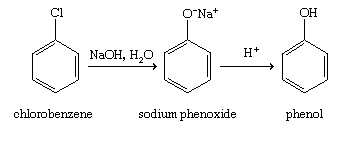
Answer
464.1k+ views
Hint: We must remember that the Chlorobenzene is an organic aromatic compound with the chemical formula\[{C_6}{H_5}Cl\]. This is colorless and due to its flammable property, it is a common solvent and a widely used intermediate to form a product.
Complete step by step solution:
We must understand that the Dow's Process is the hydrolysis of \[{C_6}{H_5}Cl\] (chlorobenzene) for the preparation of \[{C_6}{H_6}O\](phenol). When we react \[{C_6}{H_5}Cl\] (chlorobenzene) with aqueous \[\left( {NaOH} \right)\] solution it produces \[\left( {{C_6}{H_5}ONa} \right)\] sodium phenoxide and then phenol upon reacting with $H_+$.
In practical terms, we can prepare phenol from chlorobenzene when reacting with\[NaOH\], in particular two steps. First, Chlorobenzene is heated with 6-8% solution of sodium hydroxide at 623K under the pressure of 200 atm to form \[\left( {{C_6}{H_5}ONa} \right)\] Sodium Phenoxide. Then Sodium Phenoxide is acidified with dil. HCl (Hydrochloric Acid) to form \[{C_6}{H_6}O\] (Phenol).

Therefore, the answer for the question is option A. :
Note: We can also use the Dow process (electrolytic method) to extract bromine from a highly concentrated \[NaCl\] solution known as brine.
In practical, bromide-containing high concentrations of Brines are treated with \[{H_2}S{O_4}\](sulphuric acid) and bleaching powder to oxidize Br− (bromide) to Br2 (bromine), which remains dissolved in the water. The aqueous solution is shifted into the sacking bag and water is passed through causing bromine to volatilize freely. Bromine is trapped with iron turns to give a solution of \[FeB{r_3}\](ferric bromide). Treatment with more iron metal converts the \[FeB{r_3}\] (ferric bromide) to \[FeB{r_2}\](ferrous bromide).
Complete step by step solution:
We must understand that the Dow's Process is the hydrolysis of \[{C_6}{H_5}Cl\] (chlorobenzene) for the preparation of \[{C_6}{H_6}O\](phenol). When we react \[{C_6}{H_5}Cl\] (chlorobenzene) with aqueous \[\left( {NaOH} \right)\] solution it produces \[\left( {{C_6}{H_5}ONa} \right)\] sodium phenoxide and then phenol upon reacting with $H_+$.
In practical terms, we can prepare phenol from chlorobenzene when reacting with\[NaOH\], in particular two steps. First, Chlorobenzene is heated with 6-8% solution of sodium hydroxide at 623K under the pressure of 200 atm to form \[\left( {{C_6}{H_5}ONa} \right)\] Sodium Phenoxide. Then Sodium Phenoxide is acidified with dil. HCl (Hydrochloric Acid) to form \[{C_6}{H_6}O\] (Phenol).

Therefore, the answer for the question is option A. :
Note: We can also use the Dow process (electrolytic method) to extract bromine from a highly concentrated \[NaCl\] solution known as brine.
In practical, bromide-containing high concentrations of Brines are treated with \[{H_2}S{O_4}\](sulphuric acid) and bleaching powder to oxidize Br− (bromide) to Br2 (bromine), which remains dissolved in the water. The aqueous solution is shifted into the sacking bag and water is passed through causing bromine to volatilize freely. Bromine is trapped with iron turns to give a solution of \[FeB{r_3}\](ferric bromide). Treatment with more iron metal converts the \[FeB{r_3}\] (ferric bromide) to \[FeB{r_2}\](ferrous bromide).
Recently Updated Pages
A long cylindrical shell carries positive surface charge class 12 physics JEE_Main

An aqueous solution containing liquid A M Wt 128 64 class null chemistry null

What is the mole ratio of benzene left PB0 150torr class null chemistry null

Which solution will show the maximum vapour pressure class null chemistry null

Mixture of volatile components A and B has total vapour class null chemistry null

256 g of sulphur in 100 g of CS2 has depression in class null chemistry null

Trending doubts
Which are the Top 10 Largest Countries of the World?

What is the definite integral of zero a constant b class 12 maths CBSE

Differentiate between homogeneous and heterogeneous class 12 chemistry CBSE

Explain sex determination in humans with the help of class 12 biology CBSE

How much time does it take to bleed after eating p class 12 biology CBSE

Distinguish between asexual and sexual reproduction class 12 biology CBSE





